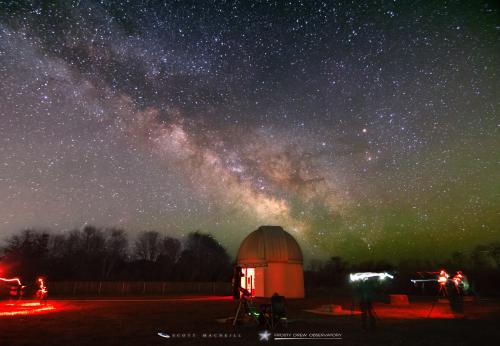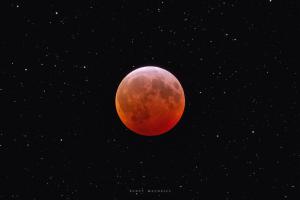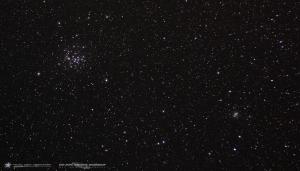Astronomical Highlights for 2019
Last month’s column focused on the Quadrantid meteor shower and the total lunar eclipse. Today I will preview some of the other astronomical highlights for 2019.
Believe it or not, Mars is still visible during early evening hours. Unfortunately, the Earth continues to pull away from Mars in our respective orbits. On February 1 the Earth-Mars distance will be about 142.7 million miles. Observing any telescopic detail on the Martian surface will require significant magnification. By the end of May, the distance between our two worlds will have increased to about 225.7 million miles. Even large telescopes will have difficulty revealing Mars’ detail.
The first of three supermoons in 2019 occurred during the Full Moon that was eclipsed back on January 20-21. Two more supermoons follow. One on February 19 (the largest Full Moon of the year), and the second on March 20. While the Moon is closer to the Earth on these dates, and therefore appears slightly larger, most folks can’t or won’t be able to discern any difference. Only when they learn that the Moon is a significant percentage larger will they agree that it does look bigger. The power of suggestion certainly holds rule. (The smallest Full Moon occurs on October 13.)
If you’ve never gotten a glimpse of the planet Mercury, then the evening of February 27 presents you the best opportunity of the year. Well, with the exception of Mercury’s transit of the Sun on November 11. More about that fantastic event a little later. Several other apparitions of Mercury occur during the year, both after sunset and before sunrise, but the February appearance will be much easier to detect. You’ll require an unobstructed view of the western horizon. Look due west about ten degrees (an outstretched fist held at arm’s length provides this measurement) above the sunset point. If you choose to focus on Mercury with a telescope you will notice that its phase will look like a waxing crescent Moon, just shy of a first quarter phase. The illuminated portion of the planet will be facing the horizon and the sunset point. Good luck.
While amateur astronomers will be observing Jupiter and Saturn early in the year when these planets are in the sky between midnight and dawn, it won’t be until mid-June that Jupiter will be more accessible during the open nights at the local observatories. Saturn will be more accessible during mid-July. If the weather cooperates during the scheduled public observing nights you can expect crowds of casual stargazers patiently waiting for good views through the beautiful instruments that are available.
Several times during 2019 the Moon will pass near or through the Beehive cluster of stars. This “swarm” of stars is located in the constellation of Cancer, which is just visible to the naked-eye in a dark sky. It covers an area roughly three Full Moons in diameter. Use a pair of binoculars to enhance your view of this beautiful sky scene. Each event will be special to observe since the Moon will appear in a variety of phases. Get an image if you can using a telephoto lens on your camera.
Here are the dates when the Moon/Beehive events are best observed between sunset and midnight: February 17, March 17, April 13 and May 10. These are the dates when the events occur between midnight and dawn: October 22 (best right after midnight); November 18 and December 15 (pre-dawn sky).
And most importantly, save the date of November 11 for another transit of Mercury. Since Mercury orbits between the Sun and the Earth, it infrequently passes in front of the solar disk due to the planet’s orbital inclination to that of the Earth. The last such transit occurred on May 9, 2016 and was seen locally, though clouds hid Mercury’s initial egress onto the solar disk. The next Mercury transit will be in November 2032 and will not be visible from our location. So, make an effort to view this 2019 special astronomical event.
While the transit is a fantastic event to observe, only experienced astronomers and knowledgeable stargazers equipped with special solar filters will be safely able to follow its progress. (I’m sure it will be broadcast on the web.) For those of you who can view the event safely, the transit will begin locally at 7:34:43 a.m. and end at 1:04:54 p.m. for a total of five hours, 30 minutes, and 11 seconds. Watch as Mercury passes very close to the center of the solar disk at 10:19:46 a.m. Further details will be provided in my November 2019 column.
In conclusion, please remember, weather permitting, the local observatories remain open during the winter months to share beautiful views of the heavens. Snow or ice can force closures, so please check the respective websites for any cancellation notices and observing schedules before venturing out for a visit. Seagrave Memorial Observatory in North Scituate is open to the public every clear Saturday night. Ladd Observatory in Providence is open every clear Tuesday night. The Margaret M. Jacoby Observatory at the CCRI Knight Campus in Warwick is open every clear Thursday night. Frosty Drew Observatory in Charlestown is open every clear Friday night year-round.
Some of the topics highlighted in this column may be covered in depth as an event date approaches.
Please clip and save the following chart showing the observing prospects for the 2019 meteor showers. These displays of shooting stars only require your eyes, dark skies, and patience to enjoy.
Keep your eyes to the skies for 2019 and always.
David A. Huestis
- Author:
- David Huestis
- Entry Date:
- Feb 4, 2019
- Published Under:
- David Huestis's Columns






